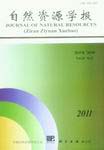Resources Ecology
ZHANG Jian-xiang, ZHANG Bo, ZHANG Hua, ZHANG Duo-yong, DAI Sheng-pei, MA Zhong-hua
Quantitative research on the pattern of landscape changes and soil erosion of Malian River Basin in Loess Plateau was carried out by means of Landsat ETM+ (2000) and Landsat TM (2007) satellite images, and supported by GIS and RS technology and methods in landscape ecology. Landscape pattern analysis software (Fragstats 3.3) was used to calculate all kinds of landscape index. Universal Soil Loss Equation (USLE) was employed to analyze soil erosion. The results are as follows: important changes took place in the past eight years in landscape patterns and soil erosion of the Malian River Basin. On the one hand, for landscape pattern change: 1) we analyzed the patch types from the level of classification. Construction land, water body, high covered grassland and forest area were increasing, especially in high covered grassland,which was increased from 593108.80 hm2 (2000) to 940098.90 hm2 (2007). Rivers, forests, construction land and reservoirs did not significantly increase and their area increases were 21278.82 hm2, 12561.13 hm2, 4863.72 hm2 and 52.11 hm2, respectively. Instead of low covered grassland, farmland areas were decreased, and the low covered grassland decreased greatly. The low covered grassland area was 542020.78 hm2 in 2000, while it was reduced to 219987.30 hm2 in 2007. The arable land, came the next, reduced by 63712.40 hm2. It can be easily found that over 5% of the low-cover grassland before 2000 was added into the high covered one in the course of the entire landscape pattern change. 2) The landscape level analysis shows that: the total number of landscape patches were 1375428 in Malian River Basin in 2000, but it decreased to 805769 seven years later; patch density decreased from 71.98 patch/hm2 in 2000 to 42.21 patch/hm2 in 2007, indicating the reduction of plaque fragmentation; diversity of the index decreased from 1.31 in 2000 to 1.23 in 2007, reflecting the gradual reduction of the number of landscape elements; patch numbers, patch density and diversity index were decreasing. That indicated a reduction for plaque fragmentation, tending to stabilization for ecosystem and gradual increasing of ecological functions. On the other hand, for the quantitative research in the soil erosion, 1) from 2000 to 2007, the landscape soil erosion modulus was decreased except reservoir. The reducing of forest land was the most significant, whose average erosion modulus decrease was 348.38 kg/(hm2·a) from 2000 to 2007. The construction land came the next, the average amount of erosion modulus decreased by 144.25 kg/(hm2·a) during this period of time, other landscape types of soil reducing was not obvious. 2) Total soil erosion decreased by 12506.76 t, which showed a significant reduction of soil erosion. Most area of Malian River Basin fell into the category of slight and mild erosion, especially the forest in the downstream areas of Ziwuling, where soil erosion was clearly changed from the moderate erosion to the ligh erosion. The river erosion in the deposition zone was more serious, and individual regions were severe erosion. The reasons for the change caused by the restoration of the local vegetation, influence of human activities, urbanization, increasing of construction land and other factors, particularly in the World Bank projects, the state policy of returning farmland to forest and grassland and the effective implementation on it.
